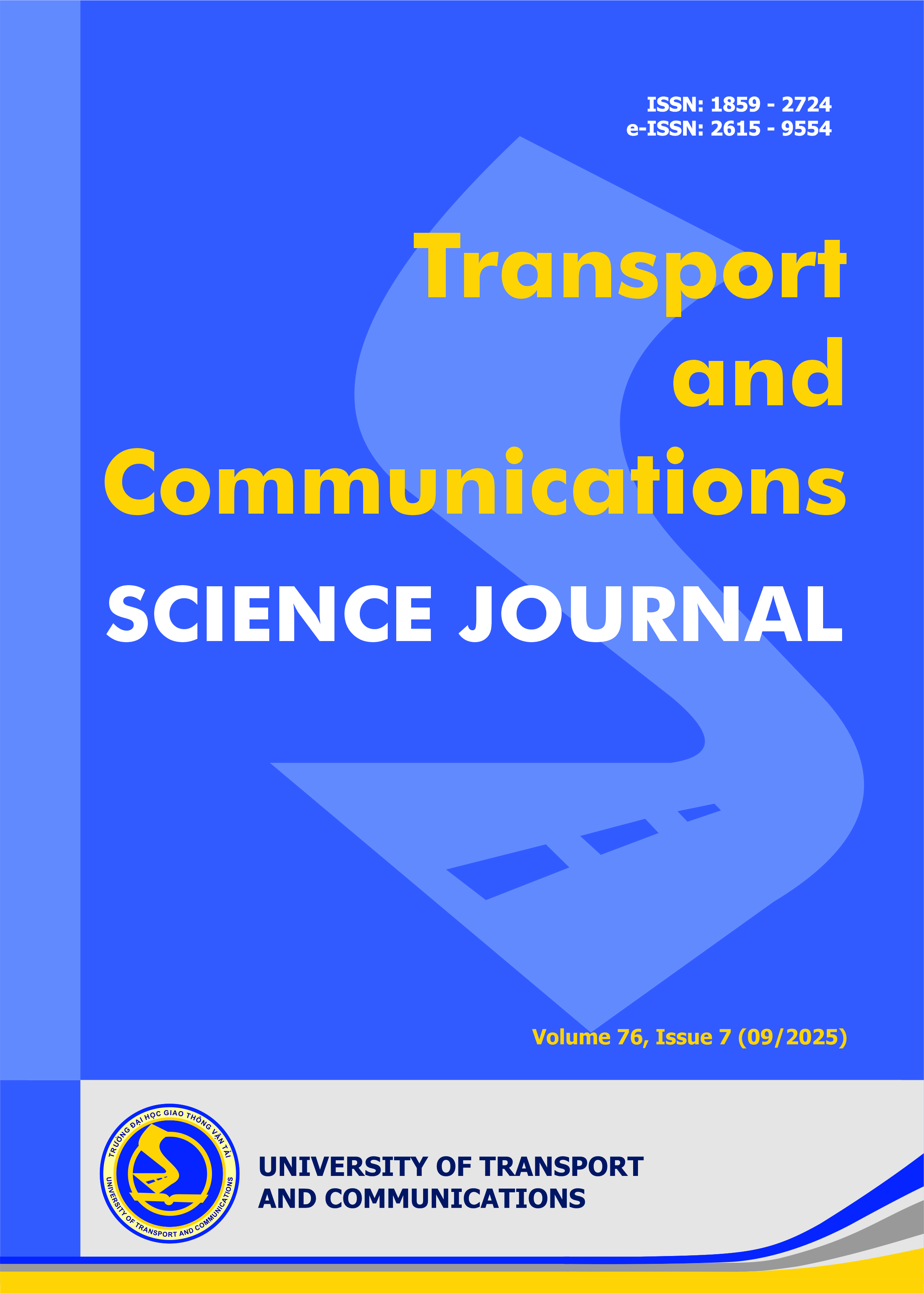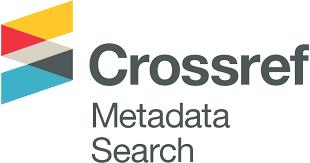Effects of compaction parameters on compressive strength of roller-compacted concrete using ground granulated blast-furnace slag
Email:
mylnt@hcmute.edu.vn
Từ khóa:
roller-compacted concrete, ground granulated blast-furnace slag, vibrating hammer, modified Proctor method, compaction energy, compaction method
Tóm tắt
Roller-compacted concrete (RCC) is a zero-slump concrete in which compaction plays a critical role in determining strength and durability. This research investigated the effects of compaction parameters on the compressive strength of RCC incorporating varying contents of ground granulated blast-furnace slag (GGBFS). Different compaction techniques, including the vibrating hammer and Proctor hammer, were evaluated along with the influence of compaction energy levels—low, standard, and high. Compressive strength tests were conducted at 7, 28, and 56 days on RCC specimens compacted using both methods. Results showed that replacing cement with GGBFS reduced compressive strength at 7 days but improved it at 28 and 56 days. Specimens compacted with the vibrating hammer consistently exhibited higher compressive strength than those compacted using the Proctor hammer. Insufficient compaction energy in the Proctor method led to a general reduction in strength across all mixtures. Conversely, increasing compaction energy slightly decreased the strength of Group A mixtures, likely due to aggregate breakage and disruption of optimal packing. In contrast, the Group B mixtures showed improved strength at higher compaction energy, likely because the energy level was sufficient to achieve maximum density. However, when the compaction energy exceeded the optimal level, a decline in strength was observedTài liệu tham khảo
[1]. M. Selvam, K. NSSP, R. Kannan, S. Singh, Assessing the effect of different compaction mechanisms on the internal structure of roller compacted concrete, Constr. Build. Mater, 365 (2022) 130072. https://doi: 10.1016/j.conbuildmat.2022.130072
[2]. E. Sengun, B. Alam, R. Shabani, I. O. Yaman, The effects of compaction methods and mix parameters on the properties of roller compacted concrete mixtures, Constr. Build. Mater, 228 (2019) 116807. https://doi: 10.1016/j.conbuildmat.2019.116807
[3]. S. G. Williams, Comparison of the Superpave Gyratory and Proctor Compaction Methods for the Design of Roller-Compacted Concrete Pavements, Transp. Res. Rec. J. Transp. Res. Board, 1557 (2013) 106–112, https://doi: 10.3141/2342-13
[4]. ASTM C1435/C1435M-08, Standard Practice for Molding Roller-Compacted Concrete in Cylinder Molds Using a Vibrating Hammer, 2008.
[5]. M. Selvam, S. Singh, Comparative investigation of laboratory and field compaction techniques for designing roller compacted concrete pavements (RCCP), Int. J. Pavement Eng., 24 (2023) 2177850. https:// doi: 10.1080/10298436.2023.2177850
[6]. A. Oner, S. Akyuz, An experimental study on optimum usage of GGBS for the compressive strength of concrete, Cem. Concr. Compos., 29 (2007) 505–514. https://doi: 10.1016/j.cemconcomp.2007.01.001
[7]. S. K. Rao, P. Sravana, T. C. Rao, Abrasion resistance and mechanical properties of Roller Compacted Concrete with GGBS, Constr. Build. Mater., 114 (2016) 925–933, https://doi: 10.1016/j.conbuildmat.2016.04.004
[8]. A. Aghaeipour and M. Madhkhan, Effect of ground granulated blast furnace slag (GGBFS) on RCCP durability, Constr. Build. Mater, 141 (2017) 533-541. https://doi: 10.1016/j.conbuildmat.2017.03.019
[9]. ASTM C150-07, Standard Specification for Portland Cement, 2007.
[10]. ASTM C109/C109M-08, Standard Test Method for Compressive Strength of Hydraulic Cement Mortars (Using 2-in or [50-mm]Cube Specimens), 2008.
[11]. ASTM C204-07, Standard Test Methods for Fineness of Hydraulic Cement by Air-Permeability Apparatus, 2007.
[12]. ASTM C191-08, Standard Test Methods for Time of Setting of Hydraulic Cement by Vicat Needle, 2008.
[13]. TCVN 11586-2016, Ground granulated blast-furnace slag for concrete and mortar, 2016.
[14]. American Concrete Pavement Association, Roller-Compacted Concrete Pavements as Exposed Wearing Surface, 2014.
[15]. D. Harrington, F. Abdo, W. Adaska, C. Hazaree, Guide for Roller-Compacted Concrete Pavements,” Inst. Transp. Iowa state univerisity, 8 (2010) 104. https://trid.trb.org/view.aspx?id=1082276
[16]. M. Hashemi, P. Shafigh, M. Rehan, B. Karim, C. Duran, The effect of coarse to fine aggregate ratio on the fresh and hardened properties of roller-compacted concrete pavement, Constr. Build. Mater., 169 (2018) 553–566, https://doi: 10.1016/j.conbuildmat.2018.02.216
[17]. ASTM D1557-12, Standard Test Methods for Laboratory Compaction Characteristics of Soil Using Modified Effort (56,000 ft-lbf/ft3 (2,700 kN-m/m3)), 2012.
[18]. TCVN 3118-2022, Hardened concrete – Test method for compressive strength, (2022).
[19]. H. Wan, Z. Shui, Z. Lin, Analysis of geometric characteristics of GGBS particles and their influences on cement properties, Cem. Concr. Res., 34 (2004) 133–137. https://doi: 10.1016/S0008-8846(03)00252-7
[20]. S. Tavasoli, M. Nili, B. Serpoosh, Effect of GGBS on the frost resistance of self-consolidating concrete, Constr. Build. Mater., 165 (2018) 717–722. https://doi: 10.1016/j.conbuildmat.2018.01.027
[21]. P. J. Wainwright, N. Rey, The influence of ground granulated blastfurnace slag (GGBS) additions and time delay on the bleeding of concrete, Cem. Concr. Compos., 22 (2000) 253–257. https://doi.org/10.1016/S0958-9465(00)00024-X
[22]. B. Kolani, L. Buffo-lacarrière, A. Sellier, G. Escadeillas, L. Boutillon, L. Linger, Hydration of slag-blended cements, Cem. Concr. Compos., 34 (2012) 1009–1018. https://doi: 10.1016/j.cemconcomp.2012.05.007
[23]. C. M. Yun, M. R. Rahman, C. Y. W. Phing, A. W. M. Chie, M. K. Bin Bakri, The curing times effect on the strength of ground granulated blast furnace slag (GGBFS) mortar, Constr. Build. Mater., 260 (2020) 120622. https”// doi: 10.1016/j.conbuildmat.2020.120622
[24]. C. Hwang, Strength development of blended blast ‐ furnace slag ‐ cement mortars, J. Chinese Institue Eng., 9 (1986) 233–239. https://doi: 10.1080/02533839.1986.9676884
25]. E. Guneyisi, M. Gesoglu, A study on durability properties of high-performance concretes incorporating high replacement levels of slag, Mater. Struct., 41 (2008) 479–493. https://doi: 10.1617/s11527-007-9260-y
[26]. K. Robalo, E. Soldado, H. Costa, H. Alves, E. Júlio, Efficiency of cement content and of compactness on mechanical performance of low cement concrete designed with packing optimization, Constr. Build. Mater., 266 (2021) 121077. https://doi: 10.1016/j.conbuildmat.2020.121077
[2]. E. Sengun, B. Alam, R. Shabani, I. O. Yaman, The effects of compaction methods and mix parameters on the properties of roller compacted concrete mixtures, Constr. Build. Mater, 228 (2019) 116807. https://doi: 10.1016/j.conbuildmat.2019.116807
[3]. S. G. Williams, Comparison of the Superpave Gyratory and Proctor Compaction Methods for the Design of Roller-Compacted Concrete Pavements, Transp. Res. Rec. J. Transp. Res. Board, 1557 (2013) 106–112, https://doi: 10.3141/2342-13
[4]. ASTM C1435/C1435M-08, Standard Practice for Molding Roller-Compacted Concrete in Cylinder Molds Using a Vibrating Hammer, 2008.
[5]. M. Selvam, S. Singh, Comparative investigation of laboratory and field compaction techniques for designing roller compacted concrete pavements (RCCP), Int. J. Pavement Eng., 24 (2023) 2177850. https:// doi: 10.1080/10298436.2023.2177850
[6]. A. Oner, S. Akyuz, An experimental study on optimum usage of GGBS for the compressive strength of concrete, Cem. Concr. Compos., 29 (2007) 505–514. https://doi: 10.1016/j.cemconcomp.2007.01.001
[7]. S. K. Rao, P. Sravana, T. C. Rao, Abrasion resistance and mechanical properties of Roller Compacted Concrete with GGBS, Constr. Build. Mater., 114 (2016) 925–933, https://doi: 10.1016/j.conbuildmat.2016.04.004
[8]. A. Aghaeipour and M. Madhkhan, Effect of ground granulated blast furnace slag (GGBFS) on RCCP durability, Constr. Build. Mater, 141 (2017) 533-541. https://doi: 10.1016/j.conbuildmat.2017.03.019
[9]. ASTM C150-07, Standard Specification for Portland Cement, 2007.
[10]. ASTM C109/C109M-08, Standard Test Method for Compressive Strength of Hydraulic Cement Mortars (Using 2-in or [50-mm]Cube Specimens), 2008.
[11]. ASTM C204-07, Standard Test Methods for Fineness of Hydraulic Cement by Air-Permeability Apparatus, 2007.
[12]. ASTM C191-08, Standard Test Methods for Time of Setting of Hydraulic Cement by Vicat Needle, 2008.
[13]. TCVN 11586-2016, Ground granulated blast-furnace slag for concrete and mortar, 2016.
[14]. American Concrete Pavement Association, Roller-Compacted Concrete Pavements as Exposed Wearing Surface, 2014.
[15]. D. Harrington, F. Abdo, W. Adaska, C. Hazaree, Guide for Roller-Compacted Concrete Pavements,” Inst. Transp. Iowa state univerisity, 8 (2010) 104. https://trid.trb.org/view.aspx?id=1082276
[16]. M. Hashemi, P. Shafigh, M. Rehan, B. Karim, C. Duran, The effect of coarse to fine aggregate ratio on the fresh and hardened properties of roller-compacted concrete pavement, Constr. Build. Mater., 169 (2018) 553–566, https://doi: 10.1016/j.conbuildmat.2018.02.216
[17]. ASTM D1557-12, Standard Test Methods for Laboratory Compaction Characteristics of Soil Using Modified Effort (56,000 ft-lbf/ft3 (2,700 kN-m/m3)), 2012.
[18]. TCVN 3118-2022, Hardened concrete – Test method for compressive strength, (2022).
[19]. H. Wan, Z. Shui, Z. Lin, Analysis of geometric characteristics of GGBS particles and their influences on cement properties, Cem. Concr. Res., 34 (2004) 133–137. https://doi: 10.1016/S0008-8846(03)00252-7
[20]. S. Tavasoli, M. Nili, B. Serpoosh, Effect of GGBS on the frost resistance of self-consolidating concrete, Constr. Build. Mater., 165 (2018) 717–722. https://doi: 10.1016/j.conbuildmat.2018.01.027
[21]. P. J. Wainwright, N. Rey, The influence of ground granulated blastfurnace slag (GGBS) additions and time delay on the bleeding of concrete, Cem. Concr. Compos., 22 (2000) 253–257. https://doi.org/10.1016/S0958-9465(00)00024-X
[22]. B. Kolani, L. Buffo-lacarrière, A. Sellier, G. Escadeillas, L. Boutillon, L. Linger, Hydration of slag-blended cements, Cem. Concr. Compos., 34 (2012) 1009–1018. https://doi: 10.1016/j.cemconcomp.2012.05.007
[23]. C. M. Yun, M. R. Rahman, C. Y. W. Phing, A. W. M. Chie, M. K. Bin Bakri, The curing times effect on the strength of ground granulated blast furnace slag (GGBFS) mortar, Constr. Build. Mater., 260 (2020) 120622. https”// doi: 10.1016/j.conbuildmat.2020.120622
[24]. C. Hwang, Strength development of blended blast ‐ furnace slag ‐ cement mortars, J. Chinese Institue Eng., 9 (1986) 233–239. https://doi: 10.1080/02533839.1986.9676884
25]. E. Guneyisi, M. Gesoglu, A study on durability properties of high-performance concretes incorporating high replacement levels of slag, Mater. Struct., 41 (2008) 479–493. https://doi: 10.1617/s11527-007-9260-y
[26]. K. Robalo, E. Soldado, H. Costa, H. Alves, E. Júlio, Efficiency of cement content and of compactness on mechanical performance of low cement concrete designed with packing optimization, Constr. Build. Mater., 266 (2021) 121077. https://doi: 10.1016/j.conbuildmat.2020.121077
Tải xuống
Chưa có dữ liệu thống kê

Nhận bài
17/02/2025
Nhận bài sửa
07/08/2025
Chấp nhận đăng
09/09/2025
Xuất bản
15/09/2025
Chuyên mục
Công trình khoa học
Kiểu trích dẫn
My Ngoc Tra, L. (1757869200). Effects of compaction parameters on compressive strength of roller-compacted concrete using ground granulated blast-furnace slag. Tạp Chí Khoa Học Giao Thông Vận Tải, 76(7), 980-994. https://doi.org/10.47869/tcsj.76.7.5
Số lần xem tóm tắt
82
Số lần xem bài báo
28









